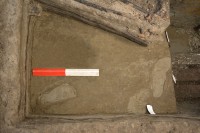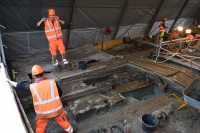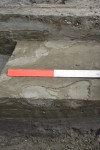 The excavations of future construction sites for the Fehmarn Belt Link tunnel continue to strike archaeological gold. Last month it was a 3,000-year-old flint dagger with an intact bark handle. Now Museum Lolland-Falster archaeologists reveal they’ve discovered two sets of Stone Age human footprints left around an extensive system of fixed gillnets, sticks of hazel mounted on stakes to form continuous weirs that trapped fish when the tide came in, on the Danish island of Lolland.
The excavations of future construction sites for the Fehmarn Belt Link tunnel continue to strike archaeological gold. Last month it was a 3,000-year-old flint dagger with an intact bark handle. Now Museum Lolland-Falster archaeologists reveal they’ve discovered two sets of Stone Age human footprints left around an extensive system of fixed gillnets, sticks of hazel mounted on stakes to form continuous weirs that trapped fish when the tide came in, on the Danish island of Lolland.
The Stone Age footprints are estimated to date back as far as 5,000 BC to 2,000 BC, to the time when water levels in the Baltic Sea were rising due to melting glaciers in northern Europe, and prehistoric people were able to use the inlets as bountiful fishing grounds. The individuals that made the footprints constructed elaborate fishing fences to catch their prey, and researchers say that the large wooden fences which interconnected to create a single continuous trap, were likely the cause of the footprints.
“What seems to have happened was that at some point they were moving out to the [fish fence], perhaps to recover it before a storm” project manager for the Museum Lolland-Falster, Lars Ewald Jensen says. “At one of the posts, the footprints were found on each side, where someone had been trying to remove it from the sea bottom.”
At least two people were involved in this rescue operation, leaving two sets of footprints of different sizes. They walked onto the wet seabed to pull up what they could of the gillnets and left deep impressions when their feet sank into the ground. Sand and mud then flowed into their prints. Thousands of years later, those prints were still clearly visible to archaeologists, both at the original depth and in dents on the surface.
 Up until land reclamation efforts in the late 19th century, the coastal area where the footprints were found was dotted with fjords and streams and subject to regular flooding from the sea. A major Baltic flood in 1872 claimed 80 lives on Lolland. As a result, a vast dyke was built along nearly 40 miles of the island’s south coast. The dyke dried out the fjords. The gillnets bear witness to the constant battle against the incursions of sea water. The wattle had to be repeatedly repaired over the lifetime of the gillnets due in part to flood damage. Museum Lolland-Falster archaeologist Terje Stafseth notes in the museum press release (pdf):
Up until land reclamation efforts in the late 19th century, the coastal area where the footprints were found was dotted with fjords and streams and subject to regular flooding from the sea. A major Baltic flood in 1872 claimed 80 lives on Lolland. As a result, a vast dyke was built along nearly 40 miles of the island’s south coast. The dyke dried out the fjords. The gillnets bear witness to the constant battle against the incursions of sea water. The wattle had to be repeatedly repaired over the lifetime of the gillnets due in part to flood damage. Museum Lolland-Falster archaeologist Terje Stafseth notes in the museum press release (pdf):
“The investigations have shown that the Stone Age population repeatedly repaired, and actually moved parts of the capture system in order to ensure that it always worked and that it was placed optimally in relation to the coast and currents. We are able to follow the footprints and sense the importance of the capture system, which would have been important for the coastal population to retain a livelihood and therefore worth maintaining.”
 These are the second-oldest human footprints found outside of Africa, with the oldest being the 800,000-year-old ones discovered on the rapidly-eroding foreshore of a beach in Happisburgh, Norfolk, in May of 2013. Most Stone Age remains recovered in Denmark are midden piles, broken tools or pottery. Archaeologists have found animal footprints from the period, but these are the first Stone Age human footprints ever found in Denmark.
These are the second-oldest human footprints found outside of Africa, with the oldest being the 800,000-year-old ones discovered on the rapidly-eroding foreshore of a beach in Happisburgh, Norfolk, in May of 2013. Most Stone Age remains recovered in Denmark are midden piles, broken tools or pottery. Archaeologists have found animal footprints from the period, but these are the first Stone Age human footprints ever found in Denmark.
Footprints and fishing trips weren’t the only discoveries on this ancient beach. Archaeologists also discovered several animal skulls from domestic and wild animals that appear to have been placed there deliberately as part of a ritual offering by farmers who inhabited the area in around 4,000 B.C. Fragments of skulls from assorted animals were placed on the coastal sea floor and then surrounded by crania of cattle and sheep. Axe shafts were placed around the skull sacrifice area which turned out to be quite large at 70 square meters (83 square yards).
The excavation is ongoing but the clock is ticking. This site along with so many others is likely to be destroyed when construction of the tunnel begins in a few months. The footprints and gillnets will be covered by an above-ground facility. All that will be left of the footprints that survived thousands of years will be flat molds taken by the archaeologists.